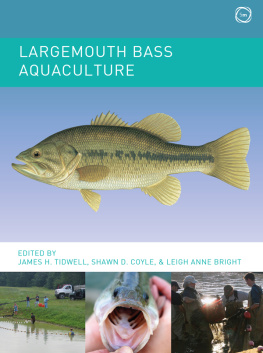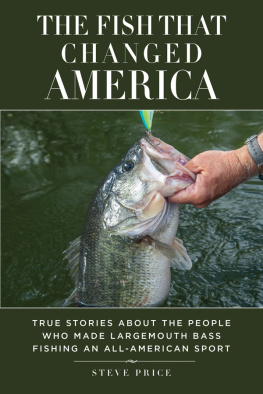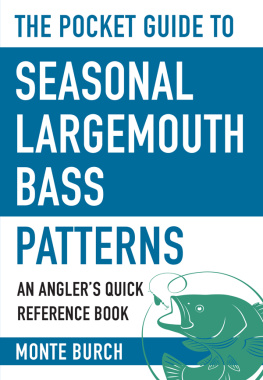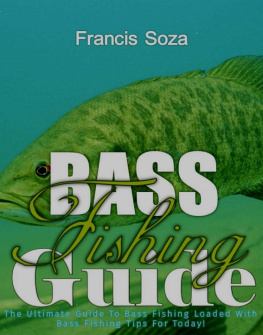Chapter 1
Largemouth bass natural history
Leandro E. Miranda
US Geological Survey, Mississippi Cooperative Fish and Wildlife Research Unit, Mississippi State, Mississippi, USA
Department of Biology, Tennessee Technological University, Cookeville, Tennessee, USA
1.1 Introduction
The largemouth bass ( Micropterus salmoides ) stands out as one of North Americas most popular sport-fish. Its common name, and other vernacular names (, Cloutman and Olmsted, 1983), reflect the striking size of its jaws, with the lower jaw projecting very strongly, and the maxilla in the adult extending beyond the hind margin of the eye. It is a member of the family Centrarchidae, a diverse and prominent family endemic to North America. The family consists of seven genera, among them the black basses, genus Micropterus , which includes multiple species. Evidence suggests that the ancestral Micropterus began allopatric speciation about 10 million years ago, driven by vicariance caused by sea-level fluctuations (Near et al., 2003; Smith et al., 2015). It is estimated that the largemouth bass separated from the Florida bass M. floridanus less than 5 million years ago (Smith et al., 2015).
The largemouth bass was first described by French naturalist Bernard Germain de Lacpde in his 1800 book Histoire Naturelle des Poissons, Volume III . The description was made in France based on a drawing and accompanying manuscript notes sent from the vicinity of Charleston, South Carolina (Henshall, 1881). The local name of the fish was trout, as it still is in some southern states. Lacpde named it Labrus salmoides , trout-like wrasse, in accordance with its general appearance and vernacular name. The genus name Micropterus is also attributed to Lacpde and his 1801 book Histoire Naturelle des Poissons, Volume IV , but he associated the name with the smallmouth bass Micropterus dolomieu . Micropterus means small fin, named after a specimen that happened to have a deformed (trimmed) dorsal fin (Henshall, 1881). The largemouth bass was not associated with the genus Micropterus until the 1870s, having some bewildering classifications in the interval that included genus names such as Bodianus, Calliurus, Lepomis, Etheostoma, Cichla, Huro, Grystes, Centrarchus , and Dioplites .
Whereas the genus classification was settled, ichthyologists have not always agreed on the number of Micropterus species. Ramsey (1975) commented that when compared with the speciose North American genus Notropis (more than 100 valid named species) and genus Etheostoma
Selected attributes of largemouth bass natural history.
| Attribute | Description |
| Scientific name | Micropterus salmoides |
| Common name (English) | Largemouth bass |
| Common name (French) | Achigan grande bouche |
| Common name (Spanish) | Lobina negra |
| Other vernacular names | Bigmouth, widemouth, bucketmouth, green bass, green trout, pond trout, Oswego bass, Welshman |
| Age of the species | <5 million years |
| Native range | Eastern North America |
| Native range area | 3,297,900 km2 |
| Naturalized range | >50 countries in all continents but Antarctica and Australia |
| Environment | Warm, eutrophic, mostly lentic, and shallow |
| Habitat | Submerged plants and underwater structures |
| Sexuality | Monomorphic, mostly monogamous |
| Nesting | Excavated substrate in shallow water |
| Age at sexual maturity | 14 years old depending on growth rate |
| Size at maturity | Minimum length near 200250 mm TL |
| Contribution of gonads to body weight during spawning season | As high as 1013% female; <2% males |
| Fecundity | F = 0.00003*TL3.407 |
| Diameter of mature eggs | 0.751.5 mm |
| Diameter of waterhardened eggs | 1.52 mm |
| Spawning temperature | Start 1416C; peaks 1820C |
| Length of spawning season | 30120 days, depending on latitude |
| Nest spacing | 36 m apart |
| Nest guarding | Males, possibly females |
| Egg hatching | 34 days |
| Total length of larvae at hatch | 4 mmTL |
| Total length of larvae at swimup | 6 mm TL |
| Average length at age 1,2, and 3 | 102, 202, 273 mm TL |
| Maximum size and age | 787 mm TL, 10.1 kg, 24 years |
| Weightlength relationships for fish >150mmTL | W = 0.000002965*L3.273 |
| Weightlength relationships for fish 25150 mm TL | W = 0.000020216*L2.858 |
| Age 0 mortality | 1020% per week |
| Age 1+ mortality | 3537% per year |
| Diet | Invertebrates to about 35 mm TL; switch to fish diet at 35160 mm TL; mostly fish afterwards |
| Daily ration | 26% of body weight |
| Gape width | Gape width = 5.59 + 0.14*TL (all units in mm) |
| Optimum temperature for growth | 2530C |
| Temperature tolerance | Juveniles stop feeding below 6C; can tolerate spells up to 40C |
| Dissolved oxygen tolerance | Growth reduced below 4 mg/l; prolonged exposure below 1 mg/l is lethal |
| Salinity tolerance | up to 812 ppt |
(over 80 species), the half-dozen or so species of Micropterus would seem to have presented a relatively straightforward problem in taxonomic definition. Nevertheless, over 40 years later the number of extant species has increased to nine (Near and Koppelman, 2009), and as many as eight additional species are being considered (Baker et al., 2013; Long et al., 2015). Until recently the Florida bass had been considered a subspecies of largemouth bass, but has now been given species status (Kassler et al., 2002); therefore, facts about largemouth bass assembled during the 20th century and reported herein reflect these two species as one.
1.2 Geography
1.2.1 Native range

Native range of largemouth bass in North America (modified from Lee et al., 1980).
Encompassing an area of 3,297,900 km2 over the eastern half of North America, the largemouth bass has the widest native distribution of the black basses (MacCrimmon and Robbins, 1975; Lee et al., 1980; Pyron, 1999). The eastern limit of its native range is the Atlantic seaboard extending northward from the St. Marys River in Georgia to the James River in Virginia in coastal watersheds (drainages from the Suwanee River in Florida to northern Mexico. The exact southwestern limit is obscured by early transplants, but would appear to have been the Rio Conchos, a tributary of the Rio Grande in north central Mexico, to the Rio Soto La Marina, a tributary of the Gulf of Mexico in northern Mexico. The western limit includes much of the western Mississippi River Basin extending into the Great Plains region where the precise boundary is variable depending on annual precipitation. It likely extends from the confluence of the Rio Conchos and Rio Grande in a northeasterly direction through central Texas, western Oklahoma, central Kansas, extreme eastern Nebraska, western Iowa, and most of Minnesota and Wisconsin south of the Rainy River and Lake Superior drainages. The northern boundary includes much of the Great Lakes basin, exclusive of Lake Superior but including the upper St. Lawrence River. The northeastern limit is the Ottawa River system southward into the St. Lawrence River and the Chaudiere River south of Quebec City. This northeastern limit extends south into the upper Ohio River drainage in western New York, western Pennsylvania, Ohio, West Virginia, and possibly western Maryland. The species is not native to the New England states or the Atlantic seaboard north of the James River in Virginia, and was absent, except peripherally, from much of the Appalachian and Ozark Mountains.










